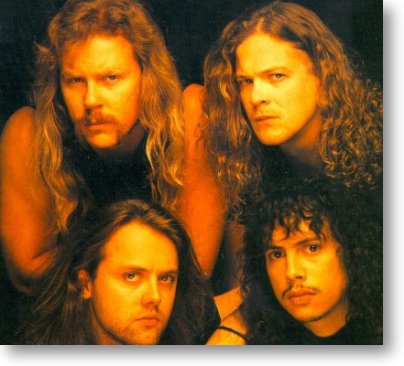This discussion might be somewhat mooted by the widespread availability of a band’s entire catalog online at the click of a few .zip links, but it used to be the case that if you wanted to dig into the work of a artist that was new to you, you had to just out and buy the record. Couple that with this particular writer’s having gotten into metal without the influence of friends, or older siblings, or tape trading or ‘zines or anything else that might have given some pointers on the best albums with which to dive into an unknown band’s vast oeuvre, and you wind up with what look like, in retrospect, some pretty fucking wacky starting points.
Allow me to illustrate:
The first Megadeth record I bought and listened to was 1997’s Cryptic Writings, a widely-panned shitstorm of wimped-out radio-friendly “thrash”-rock. Okay, so maybe it’s not the complete disaster of Risk, but it’s really a fairly awful album. The first couple of singles for the album received heavy radio play, though, and my teenaged self thought, “Hey, this sounds pretty alright.” I got the record, didn’t play it too much, and probably wound up selling it years later. The miracle is, then, that I ever managed to get into Megadeth “for real.” I think I eventually stumbled on a used copy of Countdown to Extinction, which rekindled my interest in the band, and as my appetite for metal compelled into more research, I inevitably found my way into the band’s first four classic albums.
So, there are actually two points in my mind about that: Number one, how shitty is it if you stumble upon a band just at the time that they happen to release one of their all-time poorest showings? What if I had never recovered from the bland shock of Cryptic Writings? “Hangar 18” could still be sitting out there in the distance, far outside my realm of awareness, screaming and thrashing and raging for all the world to be heard, but to no avail. Second, though: What if your first encounter with a band is with their far and away best album? To stick with the Megadeth example, what if your first Megadeth album was Rust In Peace? (I know metaldom’s opinion is somewhat split as to the extent by which RIP outstrips Peace Sells, Killing…, So Far…, etc., but to these ears it’s not even a close competition – Rust In Peace smokes everything else Mustaine et al put to wax by a wide country mile.) From that point on, everything’s going to be a letdown. You can dig into the band’s past to trace the roots of that miraculous album, and you can follow where its success took the band, and even where its dulcet tones stoked the fires for other bands, but that initial, revelatory experience is essentially never to be reclaimed.
(On a short aside, I’m pretty certain that my first Metallica album was Load. By most counts, that would be a fairly disastrous starting point for Metallica’s discography, but since Metallica seems to be the one actual metal band that gets a free pass on most hard rock radio, I grew up hearing enough of the band’s real baroque thrash output that I could recognize Load for the stylistic turn for the worse that it certainly was. Therefore, I wasn’t turned off, and quickly acquired Ride the Lightning, Master of Puppets, and everything else.)
It doesn’t always work that way, though. Even though Reign In Blood is generally accepted as Slayer’s finest hour (though I think there’s probably a case to be made for South Of Heaven as the better record; still, it’s tough to dispute RIB’s historic status), I don’t think someone getting into Slayer with RIB would necessarily be at the same disadvantage as someone getting into Megadeth with RIP. Thing is, I’m hard-pressed to figure out exactly why that is. I suppose it’s probably because I don’t see as huge a gap in terms of quality between Hell Awaits–Reign In Blood–South Of Heaven as I do between So Far…–Rust In Peace–Countdown to Extinction. That having been said, my first Slayer album was actually Divine Intervention, which is kind of a weird spot to drop into the discography, but not as confusing as, say, Undisputed Attitude or God Hates Us All would be.
On that same note, the first albums that I acquired by Opeth, Darkthrone, and Dream Theater were Blackwater Park, A Blaze In The Northern Sky, and Scenes From A Memory, respectively. None of those three albums necessarily has a consensus as to being the band’s all-time greatest, but there’s enough critical praise behind each one that they could have been potentially standard-setting albums. And in fact, each one likely remains my favorite album by each band. Nevertheless, I have subsequently acquired every single album by all three bands, and haven’t felt the same sense of inevitable resignation that I think I would have felt had I stumbled across Rust In Peace before Cryptic Writings.
I wonder if the extent to which one experiences these weird starting points is mostly dependent on whether the band in question has produced any truly oddball albums. Like, this whole conversation doesn’t make much sense if we’re talking about Motörhead or, to take a fairly timely example, Amon Amarth. You can hate or love the band, and you can certainly make distinctions in quality between albums by each band, but neither band has produced any albums that are so radically different from the rest of its canon that a listener stumbling across them would be fed an entirely wrong perception of other albums.
On the other hand, a band like Boris or the Melvins would seem to buck this trend for precisely the opposite reason: both bands do enough experimentation and total stylistic shifts (more so with Boris than the Melvins, to be sure) that neither band necessarily has any good or bad starting points. Instead, most starting points are probably equally strange, or at least sit reasonably well at odds with the bulk of the band’s other albums.
That having been said, here are just a couple of other strange discographic starting points in which I’ve found myself embroiled:
At the time, I had never heard of Cradle Of Filth, so I’m not even entirely sure what motivated me to pick up this album (I assume it wasn’t the horrifically garish cover art). More importantly, though, I had no idea that this was a completely strange stop-gap release between albums, comprised of a few new tunes, a couple of new ambient/classical interludes, a Sisters of Mercy cover, and some rerecorded songs from Cradle’s debut album, The Principle of Evil Made Flesh. I enjoyed this release enough, though, to continue on and work both backwards and forwards, and Cradle Of Filth remains an entirely guilt-free guilty pleasure to this day.
So, yeah, that album art is a nasty ol’ piece of shit. The album’s actually pretty good, though, but if you’ve heard it and any of Septic Flesh’s other material, you know it’s an odd spot at which to first dip one’s toes in the Greek metallers’ waters. It’s a strange hybrid electro-death metal trip, and the band has never really delved in the same dirges again. Seems like this would be a band that you’d either get into from the earliest black metal albums and follow them through, or else you’d be better served starting off with Sumerian Daemons and just working on from there.
——————————
So, what about you? Have you had any similar experiences, either with getting into a band with a completely fucked-up, non-representative album, or with getting into a band with their far and away best album? Or, more generally, when you know you want to investigate a band that’s new to you, do you have a particular strategy? Do you start with the most recent album and work backward? Do you start from the beginning and move to the present? Do you first reach to the most widely-acclaimed album to see if it does anything for you, and only after that point reach both forward and backward if you like what you hear?














